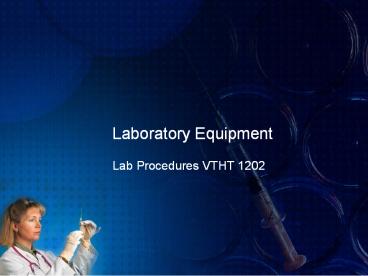Laboratory Equipment - PowerPoint PPT Presentation
Title:
Laboratory Equipment
Description:
Centrifuge Used to separate substances of different densities that are ... Blood Collection Equipment Continued Syringes should be picked based on one closest to ... – PowerPoint PPT presentation
Number of Views:144
Avg rating:3.0/5.0
Title: Laboratory Equipment
1
Laboratory Equipment
- Lab Procedures VTHT 1202
2
Centrifuge
- Used to separate substances of different
densities that are in a solution. - Supernatant the liquid component of a sample.
- Sediment the solid component of a sample
- Different types of centrifuges are used in
veterinary medicine.
3
Centrifuge Types
Angled Head Most Common
Horizontal (Swing-Arm)
Microhematocrit
4
Centrifuged Blood Sample
5
Microhematocrit Tubes
6
Blood Collection Tubes
- Different types of tubes are used depending on
what type of sample is desired. - Whole Blood- Purple (lavendar) top tube or green
top tubes
7
Blood Collection Tubes Continued
- When looking at serum or other factors, use
different type of tubes. - Oxalate Tubes GREY TOP
8
Blood Tubes Continued
- Citrate Tubes BLUE TOP
9
ACD (acid citrate dextrose)
- Used in blood collection for transfusions.
- Blood is stored in ACD vials or bottles and given
to anemic patients.
10
Blood Collection Equipment
- Use the largest gauge of needle that is
comfortable for animal. - As gauge size increases, needle diameter
decreases.
11
Blood Collection Equipment Continued
- Syringes should be picked based on one closest to
desired volume of blood. - A larger syringe may collapse the vessel.
12
Syringe Sizes
- 1cc Tuberculin
3cc
6cc
13
Blood Collection Continued
- Vacutainer allows blood to be collected directly
into a blood collection tube.
14
Refractometer
- Total solids meter.
- Used to measure the refractive index of a
solution. - Refraction is the bending of the light rays as
the pass from one medium into another. - Refractometer in vet med is used to measure
specific gravity of urine and plasma protein
levels. - Know how to calibrate refractometer
15
Blood Chemistry Analyzers/ CBC Machines
- Generates data on organ function and complete
blood counts. - Machines count cells based on size of cells in a
predetermined sample.
16
Vet Test -IDEXX
- Chemistry Analyzer
17
(No Transcript)
18
Incubators/ Agar plates
- Used in microbiological tests.
- Sustains temperature settings (37 C)
- Agar plates are inoculated with potential
bacteria. - Plates are smeared with inoculation loops.
Curettes
Incubator
Culture Plates
19
Pipettes
- Gives the ability to transfer liquids from one
place to another. - May be plastic or glass
20
Culture Swabs
21
Slides
- Thin sheet of glass used to hold objects for
examination under a microscope. - Usually place specimen in center of slide to
view.
22
Cover Slips
- Smaller, sheet of glass that may cover specimen.
- Purposes are
- To protect microscopes objective lens from
contacting the specimen - Creates an even thickness for viewing.
23
Washing glassware
- Wash with soap, detergent, or cleaning powder.
- Wash with hot water.
- Wash as quickly as possible after use. If a
thorough cleaning is not possible immediately,
put glassware to soak in water. - All parts of glassware should be thoroughly
scrubbed with a brush. - Use brushes that will not scratch or abrade the
glass surface.
24
Drying and Storing Glassware
- If glassware is to be dried, allow it to drain or
use paper towels. - Never tap glassware against the side of the sink!
- Dry labware by
- Hanging on wooden pegs or placing them in baskets
with mouths downward allowing them to dry in the
air - Protect glassware from dust by plugging mouth and
storing in a dust free cabinet.
25
Technician Role Re Lab Equipment
- Technician should have a thorough knowledge of
all in-house laboratory equipment. - Have lab manufacturers phone numbers readily
available for assistance. - Know how to operate laboratory instruments.
- Know how to clean appropriately.
- Know requirements, calibration measures, etc.
26
Sharps Container
- Always use an approved Sharps container to
dispose of contaminated sharps. - When 2/3 full dispose in compliance with
Hazardous Waste Management Plan.
27
Recall the Metric System
28
Rules of Lab
- 1. NO FOOD OR DRINKS!!!
- Listen to instructions.
- No horseplay
- Do not handle contact lenses
- 5. Dispose of or clean all used instruments and
slides accordingly. - 6. Use sharps containers
- 7. Make sure that workstations are neat and
clean. - 8. Make sure to wear appropriate attire and PPE
when told.
29
Watch Safety Video
- http//www.youtube.com/watch?vaEjVSMeFHqsfeature
related































